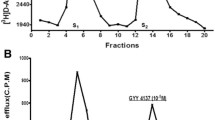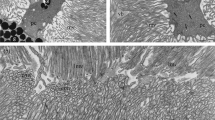Abstract
The divalent cation requirements of NOS activity in bovine retina homogenate supernatant were investigated. Supernatants were assayed under standard conditions (in mM: EDTA 0.45, Ca2+ 0.25, Mg2+ 4.0). In order to investigate the enzyme's dependence on divalent cations, the tissue homogenate was depleted of di- and trivalent cations by passing it over a cation-exchange column (Chelex 100). Surprisingly, NOS activity was 50-100% higher in this preparation. However, addition of either EDTA (33 μM) or EGTA (1 mM) almost fully inhibited NOS activity, suggesting a requirement for residual divalent metal cation(s). Phenanthroline or iminodiacetic acid at low concentrations had little effect on activity, suggesting no requirement for Fe2+, Zn2+ or Cu2+. Ca2+ had a moderate stimulatory effect, with an optimum activity around 0.01 mM. Mg2+ or Mn2+ had little effect at concentrations < 0.25 mM. However, in the presence of EDTA, Mn2+ or Ca2+ markedly stimulated NOS activity with the optimum at 0.1 mM. At high concentrations (> 0.1-0.2 mM), all divalent cations tested (Ba2+, Zn2+, Co2+, Mn2+, Mg2+, Ca2+), as well as La3+, dose-dependently inhibited NOS activity. We propose that retinal NOS requires low concentrations of naturally occurring divalent metal ions, most probably Ca2+, for optimal activity and is inhibited by high di- and trivalent metal concentrations, probably by competition with Ca2+.
Similar content being viewed by others
References
Goldstein IM, Ostwald P, Roth S: Nitric oxide: A review of its role in retinal function and disease. Vis Res 36: 2979-2994, 1996
Blute TA, Mayer B, Eldred WD: Immunohistochemical and localization of nitric oxides in turtle retina. Vis Neurosci 14: 717-729, 1997
Djamgoz MB, Aguilo R, Greenstreet EH, Reynolds R, Wilkin GP: Histochemistry of NADPH-diaphorase–a marker for neuronal nitric oxide synthase in the carp retina. Neurochem Int 28: 283-291, 1996
Perez MT, Larsson B, Alm P, Andersson KE, Ehinger B: Localization of neuronal nitric oxide synthase–immunoreactivity in rat and rabbit retinas. Exp Brain Res 104: 207-217, 1995
Goureau O, Lepoivre M, Mascarelli, Courtois Y: Nitric oxide synthase activity in bovine retina. Structures and function of retinal proteins 221: 395-398, 1992
Margulis A, Sharuma RK, Sataramayya A: Nitroprusside sensitive and insensitive guanylate cyclase in retinal rod outer segments. Biochem Biophys Res Commun 185: 909-914, 1992
Venturini CM, Knowles RG, Palmer RM, Moncada S: Synthesis of nitric oxide in the bovine retina. Biochem Biophys Res Commun 180: 920-925, 1991
Goureau O, Lepoivre M, Courtois Y: Lipopolysaccharide and cytokines induce a macrophage-type of nitric oxide synthase in bovine retinal pigmented epithelial cells. Biochem Biophys Res Commun 186: 854-859, 1992
Park CS, Gianotti C, Park R, Krishna G: Neuronal isoform of nitric oxide synthase is expressed at low levels in human retina. Cell Mol Neurobiol 16: 499-515, 1996
Sheng H, Ignarro LJ: Biochemical and immunohistochemical characterization of nitric oxide synthase in the rat retina. Pharmacol Res 33: 29-34, 1996
Geyer O, Podos SM, Mittag TW: Nitric oxide synthase activity in tissues of the bovine eye. Graefe's Arch Clin Exp Ophthalmol 235: 786-793, 1997
Forstermann U, Schmid HHW, Pollock JS, Sheng H, Mitchell JA, Warner TD, Nakane M, Murad F: Isoforms of nitric oxide synthase. Biochem Biophys Res Commun 42: 1849-1857, 1991
Marletta MA, Yoon PS, Iyengar R, Leaf CY, Wishnok JS: Macrophage oxidation of L-arginine to nitrate and nitrite: Nitric oxide is an intermediate. Biochemistry 27: 8706-8711, 1988
Mittal CK, Harrell WB, Mehta CS: Interaction of heavy metal toxicants with brain constitutive nitric oxide synthase. Moll Cell Biochem 149/150: 263-265, 1955
Persechini A, McMillan K, Masters BS: Inhibition of nitric oxide synthase activity by Zn2+ ion. Biochemistry 34: 15091-15095, 1995
Quinn MR, Harris CL: Lead inhibits Ca(2+)-stimulated nitric oxide synthase activity from rat cerebellum. Neurosci Lett 196: 65-68, 1995
Bredt DS, Snyder SH: Nitric oxide mediates glutamate-linked enhancement of cGMP levels in the cerebellum. Proc Natl Acad Sci USA 86:9030-9033, 1989
Bradford MM: A rapid and sensitive method for the quantitation of microgram quantities of protein utilizing the principle of protein-dye binding. Anal Biochem 72: 248-254, 1976
Yui Y, Hattori R, Kosuga K, Eizawa H, Hiki K, Ohkawa S, Ohnishi K, Terao S, Kawai C: Calmodulin-independent nitric oxide synthase from rat polymorphonuclear neutrophils. J Biol Chem 266: 3369-3371, 1991
de Cavalho RP, de Faria MH, do Nascimento JL, Hokoc JN: Development of NADPH-diaphorase in the avian retina: regulation by calcium ions and relation to nitric oxide synthase. J Neurochem 67(3): 1063-1071, 1996
Brennan JK, Mansky J, Roberts G, Lichtman MA: Improved methods for reducing calcium and magnesium concentrations in tissue culture medium: Application to studies of lymphoblast proliferation in vitro. In Vitro 11(6): 354-360, 1975
Schmidt HW, Pollock JS, Nakane M, Gorsky LD, Forstermann U, Murad F: Purification of a soluble isoform of guanylyl cyclaseactivating-factor synthase. Proc Natl Acad Sci USA 88: 365-369, 1991
Mayer B, Schmidt K, Humbert P, Bohme E: Biosynthesis of endothelium-derived relaxing factor: A cytosolic enzyme in porcine aortic endothelial cells Ca2+-dependently converts L-arginine into an activator of soluble guanylyl cyclase. Biochem Biophys Res Comm 164: 678-685, 1989
Pollock JS, Forstermann U, Michell JA, Warner TD, Schmidt HW, Nakane M, Murad F: Purification and characterization of particulate endothelium-derived relaxing factor synthase from cultured and native bovine aortic endothelial cells. Proc Natl Acad Sci USA 88: 10480-10484, 1991
Yamazaki J, Urushidani T, Nagao T: Barium activates rat cerebellar nitric oxide synthase. Jpn J Pharamacol 70: 351-354, 1996
Yamazaki J, Ohara F, Harada Y, Nagao T: Barium and strontium can substitute for calcium in stimulating nitric oxide production in the endothelium of canine coronary arteries. Jpn J Pharmacol 68: 25-32, 1995
Author information
Authors and Affiliations
Rights and permissions
About this article
Cite this article
Geyer, O., Podos, S.M., Oron, Y. et al. The effect if divalent cations on bovine retinal NOS activity. Mol Cell Biochem 204, 11–16 (2000). https://doi.org/10.1023/A:1007037307370
Issue Date:
DOI: https://doi.org/10.1023/A:1007037307370




